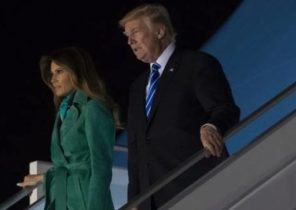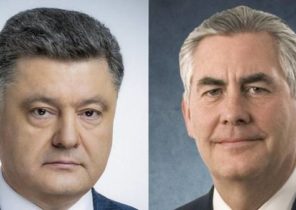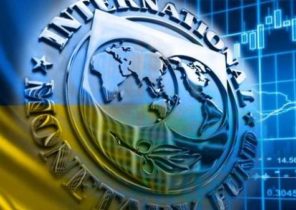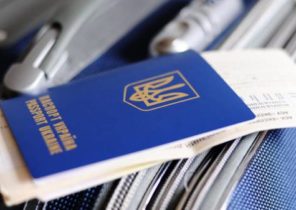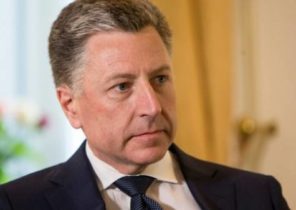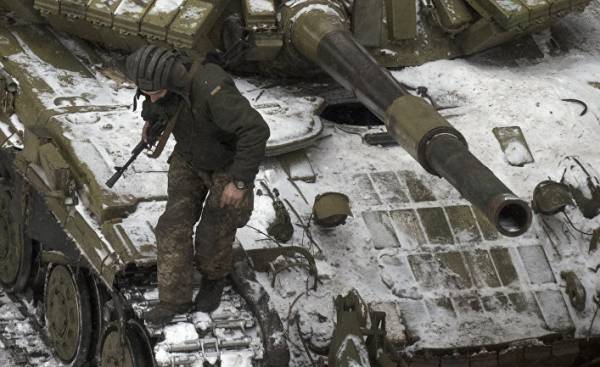
The expert group East StratCom was created in order to expose Russian propaganda and misinformation. But now the EU office he works “at least on the verge of misinformation”, says an expert on Ukraine.
About a month ago in Eastern Ukraine suddenly intensified again war.
In addition to the regular daily skirmishes that have continued despite two years ago the armistice between Kiev and Moscow-backed separatists, broke out a real war, primarily around the town of Avdiyivka, which is located on the Kiev-controlled territory near the front line.
Tanks. The heavy artillery. Advanced missile systems. Bombed-out houses. Killed 14 civilians and at least 32 soldiers.
The most severe battles with the time in February 2015 was concluded on the Second Minsk agreement, according to Alexander hug (Alexander Hug) members of the Special monitoring mission of OSCE in Ukraine.
Six days later all of a sudden calmed down again, there was only habitual violations of the ceasefire by both parties. As usual accusing each other of being evil.
The creeping attack of Ukraine
“Ukraine provoked the situation,” — said the President of Russia Vladimir Putin.
“Moscow has put Avdiyivka on the brink of a humanitarian catastrophe, cruel and irresponsible,” said the President of Ukraine Petro Poroshenko.
Media in both countries followed the example of their leaders, sometimes even in more sharp terms representing the intentions of the enemy.
A number of Western media have published information about what the separatists have begun shelling residential areas with heavy weapons. But otherwise wrote other Western and Ukrainian media — among them the U.S. government-funded Radio Free Europe and the English-language Ukrainian newspaper Kyiv Post spoke about the months of “creeping Ukrainian offensive” to the so-called line of contact.
OSCE observers documented what they could, in their daily reports. Not laying the blame on either parties.
“As you can see from our reports, both sides regularly violated the Minsk agreements and the ceasefire regime”, — says the press center of the OSCE in response to the question Politiken about who provoked the escalation, and mentions that one of the main reasons for the exacerbation was “too close to the location of enemy forces in this specific region” which can be interpreted as a discreet allusion to the “creeping offensive” of the Ukrainians.
“What really happened”
Operational working group for strategic communications East StratCom working group of the EU with 11 employees, whose main task — struggle with the Russian myths and misinformation, however, did not doubt for a second.
In its weekly Review of the misinformation on 9 February, they put the plant into the spotlight and misleading infographics “What did the Pro-Kremlin media: “No Russian troops on the territory”. What really happened: “the Rebels, supported by Russia, began to bombard the Ukrainian position.”
In the following review, dated February 16, East StratCom four times refers to the previous review, to refute Russian claims that Ukraine provoked the outbreak of violence near Avdeevka. “Not Ukraine, and Russia and supported the rebels exacerbated the situation in Avdeevka”, — they wrote.
Three experts who closely follow the development of events in Ukraine, told Politiken that to place all responsibility for the escalation of the situation around the Town on one side with a reasonable degree of certainty is impossible. This is Jarabik Balazs (Balazs Jarabik), an expert on Ukraine from the American analytical center “Carnegie endowment for international peace,” Splidsboel, Flemming Hansen (Flemming Splidsboel Hansen), senior researcher, Danish Institute for international studies, and Klaus Mathisen (Claus Mathiesen), Professor, Institute of defence.
“It’s so simplified compared to reality that at least borders on misinformation,” says Balas Arabic about infographics-East StratComs.
“East StratCom just fails to mention that Ukraine does. That’s all. I have the feeling that many of those who create the reviews of misinformation, believe that their mission is to support the Ukrainian authorities”, — believes Arabic that otherwise considers the organization of the EU “useful initiative”.
Flemming, Splidsboel Hansen also believes that East StratCom performs “good and important work”, specifically — monitors and opposes the flow of propaganda and misinformation that comes from Russian state television and the press. But it is configured is critical.
“East StratCom too politicized. They have their own agenda, which reduces confidence in them,” says Flemming Hansen, Splidsboel.
“They should only deal with the misinformation that they can prove. Everything else is a slippery slope. They cut the branch on which you sit, telling some of the stories where too much ideology and which are in fact not disinformation,” he Splidsboel Hansen.
“I represent a small group getting too involved, thinking that performs incredibly important work. And I agree with them. But, in my opinion, in General in their view on what they should do and how, something is missing. This group seems to fall under the power of groupthink, something like a collective intoxication. I think it’s really sad,” says researcher Danish Institute for international studies.
EU refutes criticism — in a roundabout way
StratCom neither the East nor the European external action service did not wish to respond to the claims publicly. Instead, they cited “a source knowledgeable about the team,” which refutes the criticism in writing.
Given the daily report of the OSCE immediately after the escalation, which was about 4,000 explosions in the town and only several dozens of explosions on the side of the separatists, according to the source, it becomes “obvious who is the aggressor and it is also obvious that it was all prepared in advance.”
“It’s quite obvious. It’s not what it says OSCE. Group, the EU prefers the interpretation which at best is doubtful,” says Balas Arabic from the “Carnegie endowment for international peace,” which is also skeptical about the interpretations of the hostilities that the group of the EU on Russian disinformation gives, being them at a distance of 3 000 kilometres.
According to a source in the EU, East StratCom insists on the findings in the infographic. First, on the fact that allegedly refutes claims by Pro-Kremlin media about the absence of Russian military forces in Ukraine. Secondly, on the allegedly indisputable fact that Pro-Russian rebels began fighting around the Town. The EU source noted, moreover, that the promotion of Ukraine in the so-called grey areas between the parties to the conflict “had nothing to do with the shelling of civilians” in the town.
“How do they know that the promotion of the Ukrainian army had nothing to do with the escalation? It is their opinion, not a fact,” says Arabic and recalls that the civilians were killed on both sides.
The researcher from the “Carnegie Foundation” also believes that there is no evidence that Ukraine in this particular case it was the Russian regular troops or separatists initiated the escalation.
Mists of lies
East StratCom organized in the spring of 2015, according to the proposal including Denmark. A group of EU experts has been criticized, for example, the MP Marie Krarup (Marie Krarup, the Danish people’s party), while the Minister for foreign Affairs Anders Samuelsen (Anders Samuelsen, a Liberal Alliance) at the meeting of the foreign Affairs Committee said that Russia’s disinformation “to thwart democratic debate based on objective facts” and uses “the myths and lies that may and must be disposed of. And this is supported by the expert group of the East StratCom”.
Against this background, experts consider remarkable the fact that the EU itself uses the sources that are obviously very biased.
In his analysis of the events around Avdeevka East StratCom is trying to counteract what they called Russia’s “fog of lies”, referring exclusively to Ukrainian sources and one OSCE report, which does not make any conclusions. Ukrainian sources — one report of the Ukrainian army, two articles in Ukrainian journals and one report by Ukrainian organizations InformNapalm, in which as if to prove that “Russian occupation troops continue provocative shelling of residential areas of Donetsk,” in attempt to blame the Ukrainian army.
That might be true. This presentation looks reasonable, but without a deep knowledge of the area is impossible to determine how this is true, says Swedish expert on the geolocation, which in my line of work prefer to remain anonymous.
And therein lies the problem with using InformNapalm as the source of truth. How can you trust an organization whose slogan sounds like “We burn out the enemies information with Napalm!” and whose activists, for security reasons, wearing a mask in all the pictures?
“Most of our information is transmitted by the Ukrainian Executive authorities, which can carry out final reconnaissance and to launch a special operation to detain and destroy the enemy,” writes InformNapalm about yourself.
InformNapalm is not the main source East StratComs, but at least four weekly reports group of the EU referred to this organization.
“Employees East StratCom needs to take into account that sites like this do not stop the spread Ukrainian propaganda,” says Balas Arabic.
Press Secretary InformNapalm Michael Makaruk confirms that the organization consider themselves “fighters,” the information war against Russia, but assured that their page in 30 languages strictly adhere to the truth. He denies that InformNapalm has any relation to the Ukrainian state security service.
The peacekeepers are set up to make war
However, in contrast there is a clear link between the InformNapalm and even more controversial and secretive organization called “the Peacemaker.”
Abroad “Peacemaker” in recent years, known primarily to the fact that hacked into and published a list of names and contacts 4 500 of “terrorist collaborators”, that is, Ukrainian and foreign journalists from media such as BBC, Reuters, DR and Politiken. After all, those working on the other side of the front, which is controlled by separatists.
Many Ukrainian journalists after the publication began to receive threats, for example, Ekaterina Sergatskova, leading one of the most respected Ukrainian TV channels, “Gromadska telebachennya”. She received threatening Facebook messages and anonymous calls in which the man promised to kill her and her son, she said.
“It was horrible, and I went to the police, but this kind of thing rarely addressed in Ukraine”, — Sergatskova said that calls methods of “Peacemaker” to go “mad”.
Just as toxic and other published lists, especially the public database “Peacemaker” called “Purgatory,” which includes more than 100,000 names and personal information of people who is on dubious grounds — named state traitors and terrorists.
“The community should know the names of those who cooperated with the militants and terrorists,” said former intelligence officer Roman Zaitsev, the only semi-official figure of “the Peacemaker,” which, however, the photo in his Facebook in the mask, the only journalist who managed to interview him, Alexander Volkov of the Ukrainian Internet-newspaper “Facts and Comments”.
“Peacemaker” has always supported the Minister of internal Affairs of Ukraine Arsen Avakov and his close adviser, MP Anton Gerashchenko.
A deadly card game
To some she Tinyco, with the address of residence in Thailand — is also the mask on the Facebook page — registered Internet domain “Peacemaker”, myrotvorets.center, and four mirrors. In addition, it performs the role of translator and coordinator InformNapalm. One of the posts that she wrote on 8 February, indicates that she has administrator rights on the InformNapalm page on Facebook.
Tinyco often shares publications “Peacemaker” on Facebook, for example, a video where the playing card deck, in which the part of the shirt depicts the target, with obverse photos. Five cards represent recently killed the separatist leaders crossed a red cross. Among others, you can see, for example, war correspondent Alexander Kotz from the Russian newspaper “Komsomolskaya Pravda” in the form of a six of clubs and six of hearts depicts a British independent journalist named Graham Phillips (Graham Phillips).
One of the mirrors “Peacemaker”, psb4ukr.ninja, in April 2015 for a short time was registered to Vladimir Kolesnikov, Ukrainian address, while registration rights are not transferred Oksana, Tinyco. At the same Kolesnikova registered international domain InformNapalm, informnapalm.org February 2015-present.
Tinyco, and Kolesnikov had not responded to requests Politiken. Michael Makaruk of InformNapalm has insisted that none of them any role in the organization is not playing.
At the same time, Makaruk said that subscribes to the response which the leader of the “Peacemaker” in the email gave Politiken:
“The peacemaker” and InformNapalm is completely independent from each other organizations. We use the same forms of work and methods, but to solve different problems, although one field. Of course, sometimes we interact,” he writes.
The European external action service does not comment on the use of InformNapalm as a source, but a source knowledgeable about the work of the East StratCom, said that the group listens to any criticism, which helps to improve the analysis, published in their news reports.
This article is partly based on extensive research provided by Politiken blogger Espero Larsen (Jesper Larsen). Jesper Larsen sympathetic to Russian-backed Ukrainian separatists in Eastern Ukraine and critical of the work of the East StratCom. His previous investigations have become an important source of information for Marie Krarup (Krarup Marie), criticized the working group of the EU. All information in the article checked Politiken, which also launched its own investigation.
